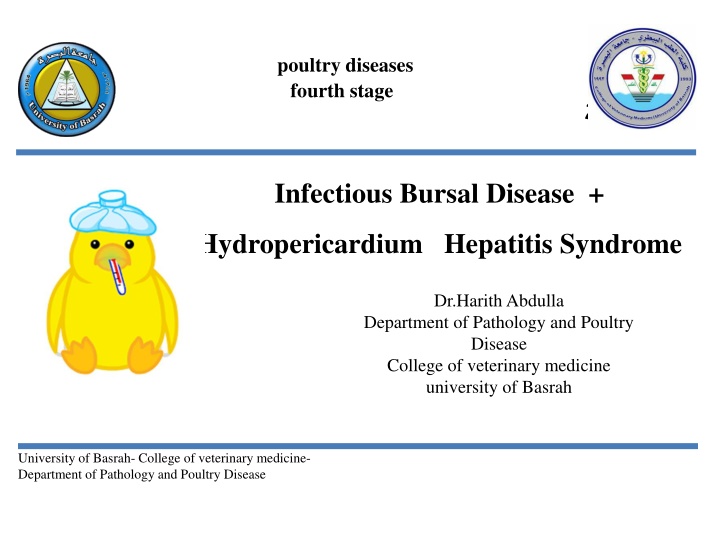
Infectious Bursal Disease (IBD) in Poultry: Symptoms, Diagnosis, and Prevention
Learn about Infectious Bursal Disease (IBD) in poultry, including its symptoms, diagnosis, post-mortem lesions, and prevention methods. Explore the types of IBD vaccines available for protecting chickens from this viral infection.
Download Presentation

Please find below an Image/Link to download the presentation.
The content on the website is provided AS IS for your information and personal use only. It may not be sold, licensed, or shared on other websites without obtaining consent from the author. If you encounter any issues during the download, it is possible that the publisher has removed the file from their server.
You are allowed to download the files provided on this website for personal or commercial use, subject to the condition that they are used lawfully. All files are the property of their respective owners.
The content on the website is provided AS IS for your information and personal use only. It may not be sold, licensed, or shared on other websites without obtaining consent from the author.
E N D
Presentation Transcript
poultry diseases fourth stage Infectious Bursal Disease + Hydropericardium Hepatitis Syndrome Dr.HarithAbdulla Department of Pathology and Poultry Disease College of veterinary medicine university of Basrah University of Basrah- College of veterinary medicine- Department of Pathology and Poultry Disease
Infectious Bursal Disease {IBD} ( Gumboro) There are two forms of the disease :- A. Acute form { Classic form }( Clinical form). B. Variant { Subclinical form } . A. Acute form: (Clinical form, Classic form) Highly contagious viral disease of young chickens characterized by :1. Edema and swelling of the bursa of Fabricius followed by hemorrhage. 2. Vent picking . 3.Diarrhea.4. Ataxia .5. Mortality in 3 - 6 weeks old birds . B: Variant : (Subclinical form) Infection prior to 3 weeks of age results in immunosuppression and bursal atrophy .
Etiology : Avibirnavirus : Double stranded RNA virus. Incubation period : 48 72 hours . Course of disease : 5 7 days . Mortality : Broilers 0 20 % . Layers 5 50 %. Method of spread :- 1. Contaminated feed and water . 2. Servicemen . 3. Trucks .
Signs : A- Clinical form 1. Occurs in broilers at 3 6 weeks of age . 2. Depression , ataxia and tremors . 3. Vent picking . 4. Diarrhea and dehydration. 5. Sudden onset , death of well fleshed birds . B-Variant :- In apparent infection .
Post mortem lesions: A- Classic form: 1. Enlarged edematous bursa of Fabricius followed by bursal atrophy . 2. Gelatinous film cover the exterior of the bursa . 3. Cheesy core may be found in the bursa . 4. Kidneys are swollen and filled with urates. 5. Extensive petechial hemorrhages on the surfaces of thighs and breast muscles . B- Variant : Small atrophic bursa of Fabricius.
Diagnosis : 1. Signs . 2. Gross lesions . 3. Histopathology . 4. Viral isolation . Serology ( ELISA ) . Prevention: 1. Vaccination. 2. Isolation and strict sanitation . 3. Maternal antibody.
Types of IBD Vaccines: 1. Live Attenuated Vaccines (mild, intermediate, intermediate plus, or hot strains): Administered via drinking water, eye drops, or spray. Used in young chicks (10 20 days old) when maternal antibodies decline. Inactivated (Killed) Vaccines: Given to breeders before laying to pass maternal antibodies to chicks. Immune Complex and Recombinant Vaccines: Used in ovo or at day 1 in hatcheries, offering early protection.
Common Vaccination Schedule Broilers: 10 14 days: Intermediate vaccine via drinking water. 18 20 days: Booster dose (if needed, based on risk level). Layers & Breeders: 10 14 days: Live vaccine. 4 6 weeks: Booster with a stronger live vaccine. 16 18 weeks: Inactivated vaccine before laying.
Hydropericardium Hepatitis Syndrome ( HHS ) ( Angara Disease ) Acute infectious disease of chickens characterized by high morbidity and mortality , excess pericardial fluid , and multifocal hepatic necrosis. It affects mainly broilers and broiler parents in rear, and has also been seen in pigeons. Etiology : Adenovirus. Possibly in combination with immunosuppression caused by Chicken Infectious Anemia or IBD. Transmission: Vertically and horizontally.
Clinical signs : 1. Age : 3-5 weeks old broiler and broiler breeder 2. Sudden onset (Sudden increase in mortality). 3. Lethargy . 4. Huddling with ruffled feathers. 5. Yellow , mucoid droppings are characteristic. 6. Mortality : 46 80 % .
Post-mortem lesions: 1- Excessive straw-coloured fluid distending the pericardium ( up to 10 ml of clear transudate in the pericardial sac). 2-Generalized congestion of the carcase. 3- Enlarged , pale friable liver and kidneys. 4-Multifocal hepatic necrosis . 5. Lungs are edematous.
Diagnosis 1- Signs. 2- Lesions. 3- Histopathological examination: demonstrates basophilic intranuclear inclusions in the hepatocytes. 4. Isolation and Identification of the virus. Differential diagnosis: 1. Coccidiosis. 2. IBD. 3. Airsacculitis.
Treatment : No treatment. Prevention : 1.Vaccination at 9-11 day of age ,subcutaneously with oil emulsion vaccine . 2.Good water sanitation (e.g. treatment of drinking water with 0.1% of 2.5% iodophor solution) appears to be beneficial. 3.Control of immunosuppressive diseases.
Types of Vaccines Used for Angara Disease (HHS) 1. Inactivated (Killed) FAdV-4 Vaccine Administration: Given via subcutaneous (SC) or intramuscular (IM) injection. Use: Used in breeders and layers to provide maternal immunity to chicks. Advantages: Provides long-lasting immunity. Reduces vertical transmission from breeders to offspring. Disadvantages: Requires two doses for full protection.
Vaccination Program for Angara Disease (HHS) For Broilers Day 1: Live attenuated FAdV-4 vaccine (eye drop or drinking water). 14-21 days: Booster with live vaccine in endemic areas. For Layers & Breeders 6-8 weeks: First dose of inactivated FAdV-4 vaccine (IM/SC injection). 14-16 weeks: Booster dose before laying starts.
